Proper pool maintenance is important for the health and longevity of the pool and for the health of people who use it. If you’re new to pool ownership or just in need of a refresher, then this article on beginner’s pool maintenance 101 is for you.
Article Contents
Beginners Pool Maintenance Tasks
This pool maintenance cheatsheet infographic will show you all you need to know to maintain your pool.
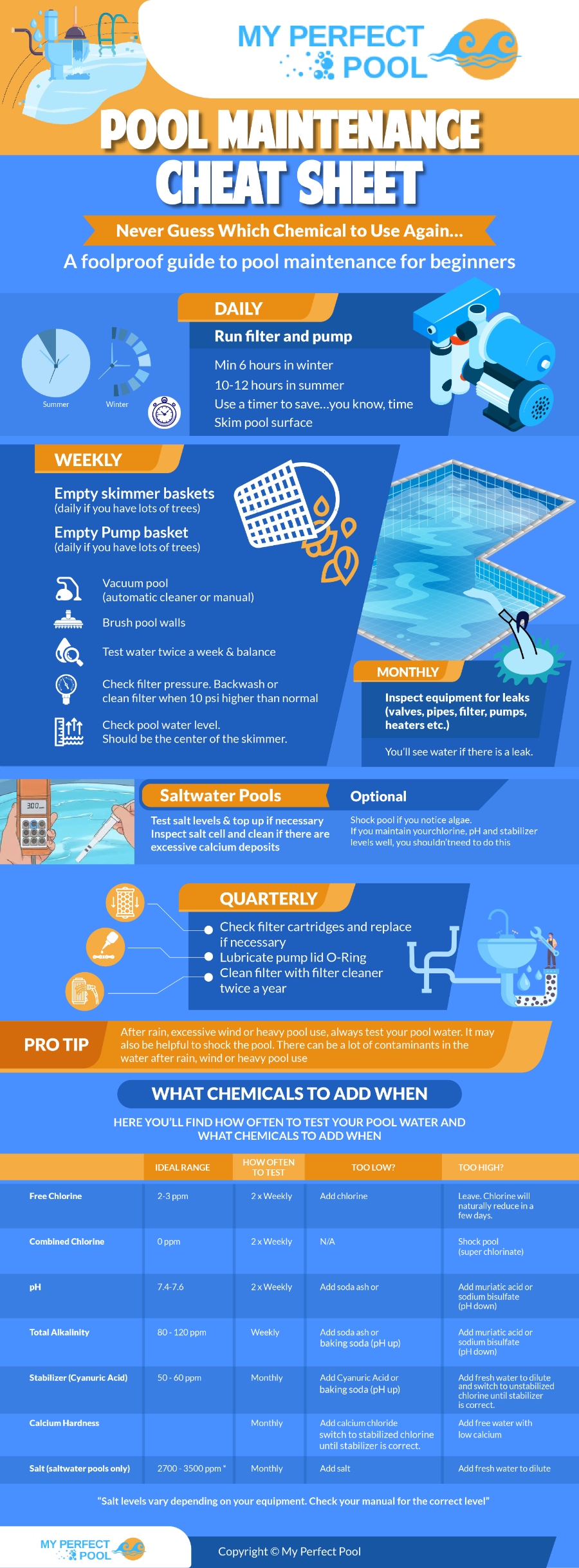
Overview of Basic Pool Maintenance
This article covers the basics of pool maintenance and proper chemical balance to keep your pool sparkling clean and healthy. But we have advice for more advanced problems on our website. Let’s dive in!
Pool maintenance is like tending to a garden. There’re a few basic procedures that need to be done at regular intervals like weeding to clean the pool. And others that need to be performed less frequently, like fertilizing to clean the filter.
Just as gardeners have different preferences for tools, which equipment you choose is a personal preference, and you’ll be able to get the job done with different variations of the same equipment.
Our expertise in pool maintenance comes from working in the pool industry and comes from learning a lot of this stuff the hard way, and I want to make it easier for you.
Basic Pool Maintenance Tasks
- Testing the water
- Brushing the tiles, sides, and bottom to loosen any settled debris
- Skimming the pool surface with a net to remove any floating debris
- Cleaning the skimmer basket
- Vacuuming the sides and bottom
- Cleaning the pump basket
- Backwashing the filter (if it’s a sand or DE filter)
- Clean the filter (if it’s a cartridge)
- Running your filtration system every day
- Topping up the water level
Pool Maintenance Schedule
Barring any specific maintenance like leak detection or algae treatment, here is a routine schedule to follow.
| Task | When |
| Test Water | 1-2 times per week |
| Add Chlorine | 1-3 times per week |
| Brush walls/floor | Weekly |
| Skim surface | Weekly (more if lots of debris) |
| Empty Skimmer Basket | Weekly (more if lots of debris) |
| Vacuuming | Weekly (more if lots of debris) |
| Empty Pump Basket | Weekly (more if lots of debris) |
| Clean Filter | Monthly |
| Run Pump & Filter | 6 hrs per day in winter / 12 hrs in summer |
Once Per Week
Test the water with a kit and add chemicals if needed, brush the pool, skim the surface, and clean the skimmer basket and the pump basket. If you use a floating chlorine tablet dispenser, check if it has adequate tablets.
Also, check your water level is correct. It should be halfway up the skimmer opening. Top up your pool with a hose if it’s lower than this and check the chemical levels again after topping up.
Once Per Month
Clean your cartridge filter with a water hose, or backwash the filter if it is sand or DE.
The weekly maintenance tasks should be done on the same day. Once the pool is properly balanced and there is no accumulation of debris, this process takes less than 30 minutes on average. Below is a list of the maintenance tasks in the order that they should be done.
Pool Maintenance Tasks: When & How to Perform Them
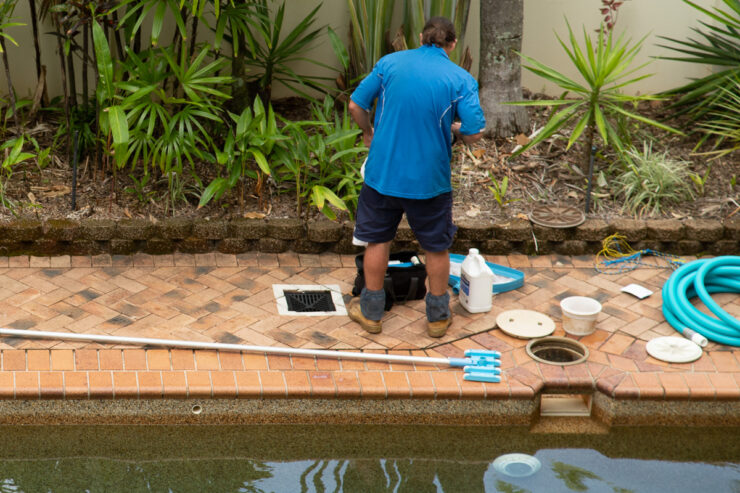
Testing the Water (1-2 Times Per Week)
Testing the water on a weekly basis is critical to maintaining proper chemical balance. You can either use test strips or a vial. I prefer using vials because they are more reliable and have explicit directions.
A basic test, and the one where the levels change frequently, is pH and chlorine or salt levels. Your pH should be between 7.4-7.6 ppm (parts per million) and the chlorine level should be between 4-6 ppm.
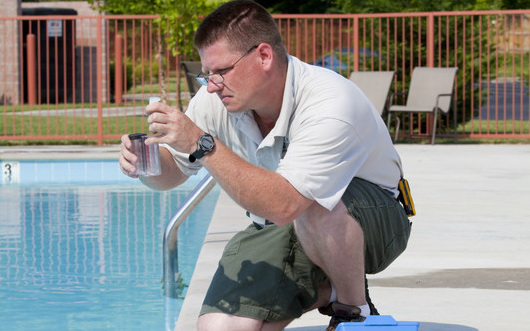
These levels change for a multitude of reasons. Chlorine dissipates when the weather is warm, or the cyanuric acid (stabilizer or conditioner) is low, or it dilutes with heavy rainfall. pH levels are altered by high chlorine levels, fertilizer overspray, or a deck that has paver stone or another masonry.
Salt levels vary from salt cell to salt cell. You can find the number on the manufacturer’s website or in the manual with the salt cell. A good range is between 3,200-4,200 ppm as a rule of thumb.
I use a Taylor kit in the field and my personal pool. Dip the vial into the water up to your elbow and add 5 drops of chlorine and pH reagents to test these levels. The kit includes other reagents that test phosphates, nitrates, and salt levels.
Why Testing is Important
Water testing is important because it reveals your pH, chlorine (or salt), and other important chemical levels. If the chemical balance is too high or too low, it will create problems.
For instance, if the chlorine is too low, your pool could turn green with algae. If the pH is too high, it affects chlorine, meaning that the chlorine is not as effective as it should be.
Brushing (Weekly)
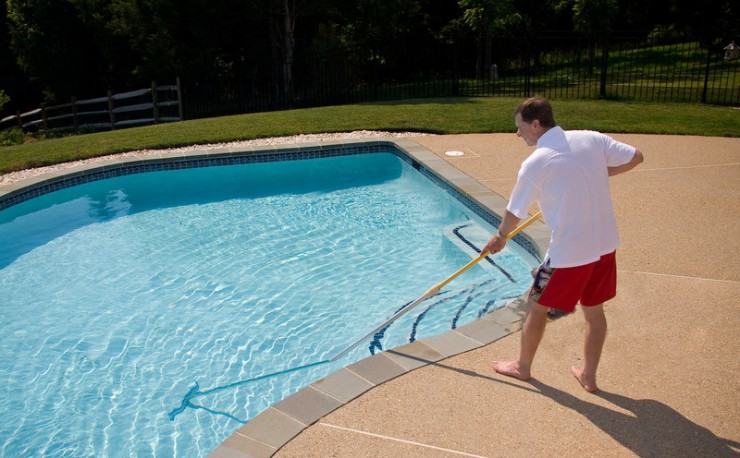
Not all fine debris, such as sand, dirt, or pollen, will be cleaned by the filtration system and will accumulate on the walls, steps, and the bottom of the pool. Brushing on a weekly basis will knock off any accumulated debris and help extend the life of the surface finish.
There are different brush heads for different-shaped pools. To use it, connect it to a telescoping pole and rigorously brush the tile line of the entire pool. Next, brush the sides and bottom of the pool with overlapping strokes toward the drain.
Why Brushing Your Pool is Important
Brushing the pool not only extends the life of the finish, it also prevents algae from forming. Brushing your pool is a preventative measure for:
Scale
Scale is a calcium buildup that shows up as a white film around your tile line.
Stains
Organic stains from dirt, minerals, and various oils, enter the pool through the surface and stain the sides.
Algae
All pool finishes can grow algae, but quartz, plaster, and aggregate finishes are more susceptible to algae blooms. These finishes have micropores which is an ideal breeding ground for algae.
Skimming (Weekly)
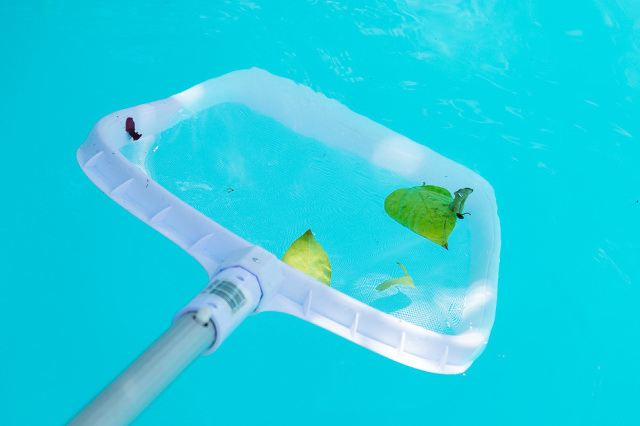
Skimming is done with a net and keeps the pool surface free of debris. This can be done on a weekly basis. But if you have a lot of overhanging trees, you may need to do this daily.
It’s best to skim after you brush because brushing will loosen any debris on the walls and bottom of the pool. If you routinely have large debris on the surface, a larger mesh net will do. You should purchase a fine mesh net if you often have finer debris.
After you brush the pool, disconnect the brush from the telescoping pole and attach the skimmer net. Skim the entire pool surface, not just what you can see. Often, there are fine particles of debris that you may not see that needs to be skimmed off.
Why Skimming Your Pool is Important
Skimming is important because it provides a sanitized path for the swimmer by skimming off debris. Another benefit to skimming weekly is that the surface debris does not go into the filtration system, which protects your pump basket and filtration system. And finally, if left to sink, leaves and other debris can not only stain the pool surface, but they leave bacteria in the water.
Emptying the Skimmer Basket (Weekly)
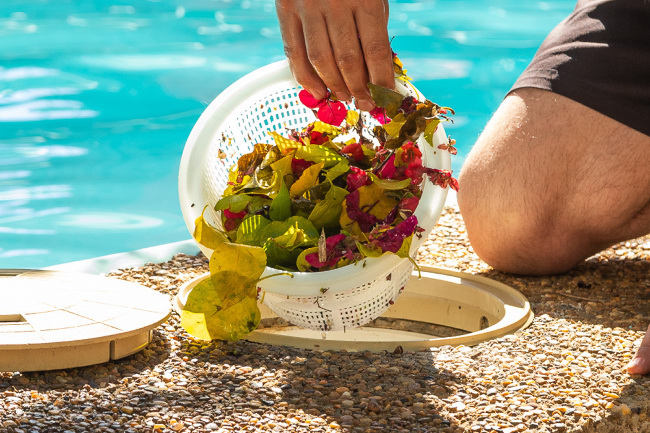
Remember when I mentioned that I learned some of this information the hard way? This is one of those steps. If you clean your baskets last, whenever you turn your filtration back on, the blower jets will blow any debris that is in the skimmer(s) back into your nice and clean pool.
To prevent this, scoop your skimmer(s) into the net that already has surface debris after you skim your pool. This also saves you from making two trips to the trashcan.
Why Cleaning the Skimmer Basket is Important
Eventually, whatever is in your skimmer basket is going to make it into your filtration system. Cleaning the skimmer basket weekly (or more if you have heavy foliage) prevents this from happening.
A clogged skimmer will also impede the pump and pool’s circulation.
Vacuuming (Weekly)
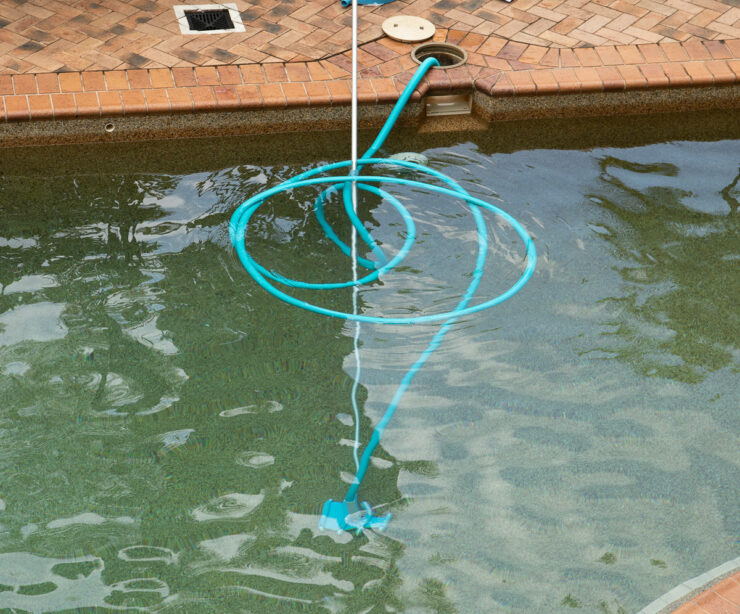
Now that you have kicked up any sediment by brushing and removed surface debris by skimming, it’s time to vacuum the pool. Unless you have an automatic cleaner, you will need to disconnect the brush from the telescoping pole and connect the vacuum. There are different vacuum heads, some connect to a port on the wall of your pool while others connect to the skimmer.
Just like when you skim, you should vacuum using overlapping strokes and vacuum the entire pool, not just the visible debris. If you don’t, you will probably see streaks at the bottom.
Why Vacuuming Your Pool is Important
Vacuuming not only cleans your pool, but it also removes potentially harmful bacteria and removes any live or dead algae that you brushed off.
Cleaning the Pump Basket (Weekly)
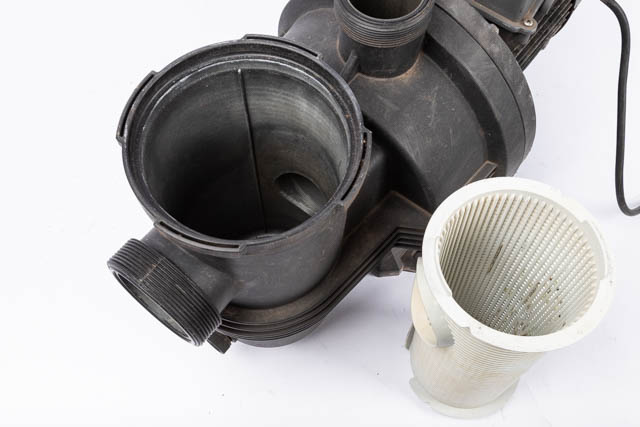
Cleaning the pump basket weekly (or more for heavy foliage) is critical to the filtration system. The more it’s clogged, the less water flow you have, and your entire system work harder, putting unwanted stress on the pump.
To clean the pump basket, turn the filtration system off and unscrew the clear lid of the pump basket. Remove the basket and dump out the contents and replace it. After a good seal on the lid, turn the system on and wait until you see the water forcefully pulling through the basket before walking away.
Why It’s Important to Clean the Pump Basket
If you don’t clean the pump basket, it can have dire consequences on your pump and pool. The filtration system provides adequate water flow to the pool and also pulls debris through the pump basket (aka strainer). The more clogged the pump basket, the less water flow it has, even though it works just as hard.
This can cause unwanted debris in your pool because not only will it not have enough suction to remove what’s already there, it will also spit out debris through the skimmer. The clogged pump basket can also cause the pump to burn out.
Cleaning the Filter (Monthly)
There are three common types of swimming pool filters: Cartridge, Sand, and DE. Each has slightly different maintenance requirements.
No matter the filtration system you have, it should be cleaned once per month. This is the final stage of your filtration system, where all the debris collects. The debris gets caught in the filter, so it will not release back into your pool.
Cartridge
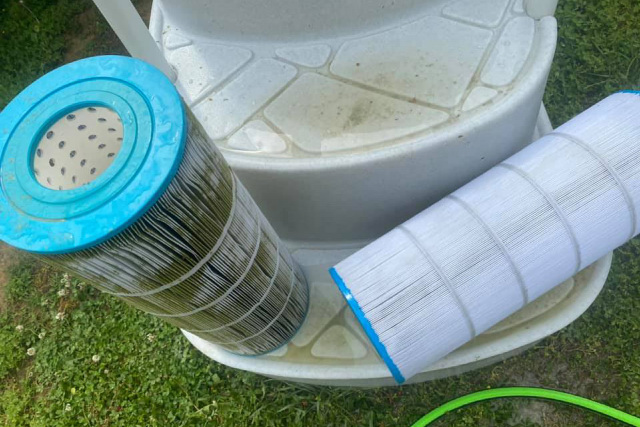
If you have a cartridge filter, remove it from the canister and place it on the ground the same way it goes into the canister. The orientation of the cartridge in the canister is important, so look for the side that says “top” and place it back in the canister correctly.
Once the filter is out of the canister and on the ground vertically, use a water hose nozzle on the jet setting and wash the vertical pleats from top to bottom. As you wash the pleats, turn the filter so you clean all the pleats.
Sand or DE
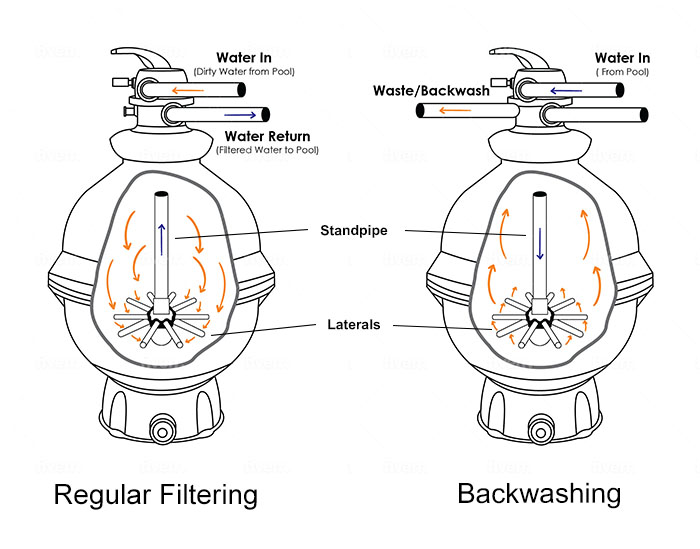
Sand and DE are specialized filters that are bulbous in design. At the top you will find a handle labelled with filter (run), waste, closed, rinse, waste, and backwash. If it is not plumbed into the ground, you will need a blue backwash hose.
Once the blue hose is connected to the valve, turn the handle to backwash. The water will circulate out through the hose. Backwash the filter until the water comes out clear, usually for a couple of minutes. Then, turn the handle to wash for one minute. This will clean out any leftover debris from the filter housing.
Backwashing lowers the level of the pool water, so you will need to refill it.
Tips for Cleaning Your Filtration System
- Don’t bang the skimmer or the pump basket on the ground to clean it. The plastic gets brittle from sun exposure and could break. Scoop the debris out with your hand instead.
- When you remove the pump basket, make sure the gasket goes back in properly or you will lose suction and, sometimes, the pump won’t operate. This is why it’s important to wait to see the water flow before you walk away. If the gasket is stretched out or broken, leave the system off until you replace it.
- If you have to backwash your system (done when the pressure is 5-10 PSI higher than usual), check the pH, chlorine or salt, and calcium levels after you refill the pool. The freshwater will dilute the pH and chlorine or salt levels, and the water is usually hard with calcium.
Properly Running Your Filtration System
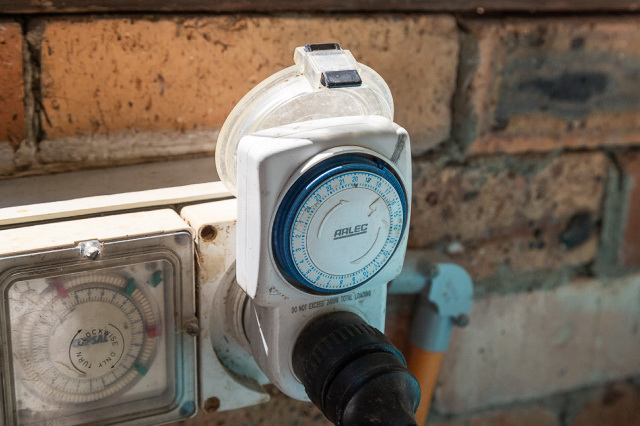
You should run your system for a minimum of 6 hours in the winter months and at least 12 hours per day in the summer months. Algae grow better in warmer conditions, and running your pump longer helps filter out algae and other bacteria.
Pro Tip: many pool owners try to save some money by running their filter less. Whilst you may save a little on electricity in the short term, the pool will require more chlorine. And you could get issues such as algae, which can be a bit pricey to fix.
Why Running Your Pool Pump is Important
Without water circulation, your pool becomes stagnant and becomes a breeding ground for bacteria. Also, any debris in the pool will not circulate out.
Pool Maintenance Tips
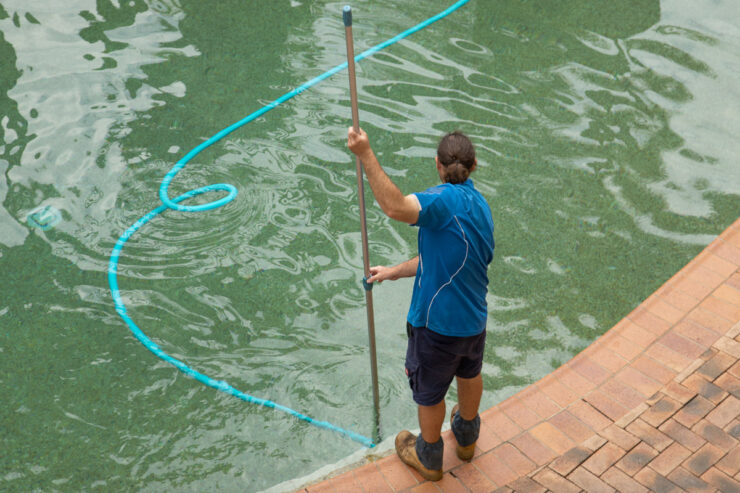
You can do plenty of other things to maintain the health and beauty of your pool by keeping debris from entering the pool. Although it’s expensive, I always recommend a screened enclosure for a pool.
This is the ultimate way to prevent any debris from entering the pool. Whether you have a screened enclosure or not, here are some useful tips.
- A pool cover is cheaper than a screened enclosure and will keep debris out. There is even a liquid version (that will keep the water warmer but not keep debris out).
- A child enclosure around the pool also keeps pets and other animals away from and out of your pool.
- Trim any overhanging shrubbery or tree branches from around the pool.
- If your chemical balance numbers are way off a couple of times in a row, bring a sample of your pool water and your tester to a pool supply store. They will test the water (usually for free), and you can compare the notes to your reading. Often, the pool chemistry is fine; either the tester is bad, or you didn’t apply the right reagent. No big deal; it happens to all of us. It never hurts to get a second opinion.
How to Maintain Your Pool Equipment
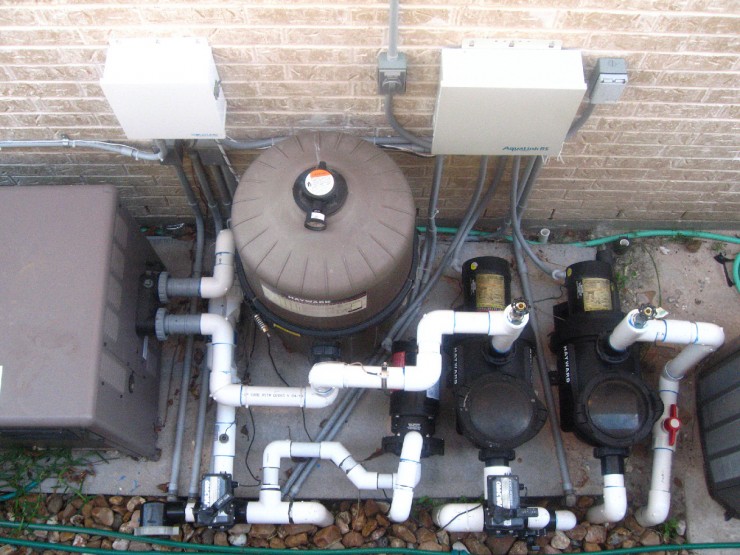
Inspecting and maintaining your pool equipment is not only good for the health of your pool, but it can also save a lot of money on repairs or replacing expensive pool equipment.
When you clean your pool, you should do a cursory inspection of your pump’s system to look for obvious signs of damage. Common things to look for include your water level, leaks from the filtration system, and proper water circulation.
Of course, there are different types of systems with different operating systems, but common leak detection and other things are common no matter what system you have.
When you step onto your pool deck, look around the pool and see if your water level is receded or if there are any stains on the pool walls from the last time you cleaned it. If the water level is receding quickly and you don’t think it’s evaporation, you need to buy a leak detector or call a professional to determine where the leak is coming from.
After briefly looking at the immediate pool area, check out the pump and/or heater area. Make sure the pipes, pump, and discharge valve are not leaking. Look over the heater if you have one to ensure it works properly.
If you have a salt system, look at the cell to see if the lights are green. Once you determine that everything is operating properly, do the routine maintenance.
Common Pool Problems
Here is a list of common pool problems that every pool owner should know. If you have more specific problems, check out the problem section of our website.
Algae/Green Pool
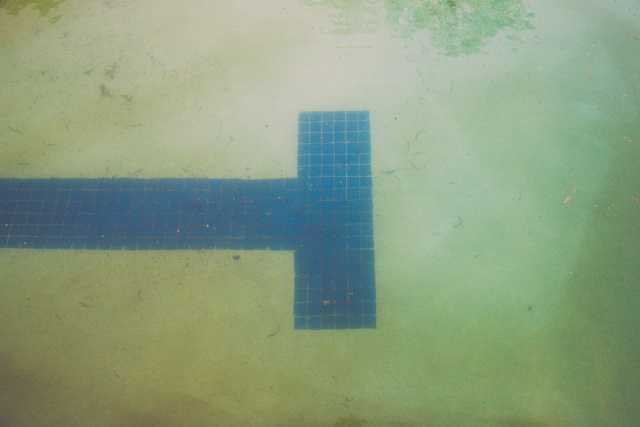
If your pool is green, you must treat algae immediately. First, brush the pool vigorously. The chlorine won’t penetrate the algae unless you brush off the initial layer. An algae treatment takes 24 hours, and once the algae are gone, clean the filter again to remove the dead algae.
Cloudy Pool Water
Cloudy water is usually an indication that the chlorine isn’t working effectively. You should not swim in a pool with cloudy water because could be a strong presence of bacteria that can cause eye irritation and/or stomach issues. To get rid of cloudiness, clean the pool as you normally do, shock it, let the system run for 24 hours, and add a clarifier.
We have a full article on clearing cloudy pool water.
Leaking Pool Pumps
A leaking pump can be several things. Either the lid was not put on properly, it needs a new gasket, or the top needs to be tightened. It is best to contact a professional pool maintenance company if it’s anything other than these.
We have a full article on fixing a leaking pool pump.
High Pressure in Filter/Pump
The most common reason for high pressure is that the filter needs cleaning. The filter pleats absorb and filter out dirt and debris. Sand filters build up with debris. If the filter is clogged, it will not work properly and cause higher pressure in your pool than usual. Clean it or backwash it.
Low Pressure in Filter/Pump
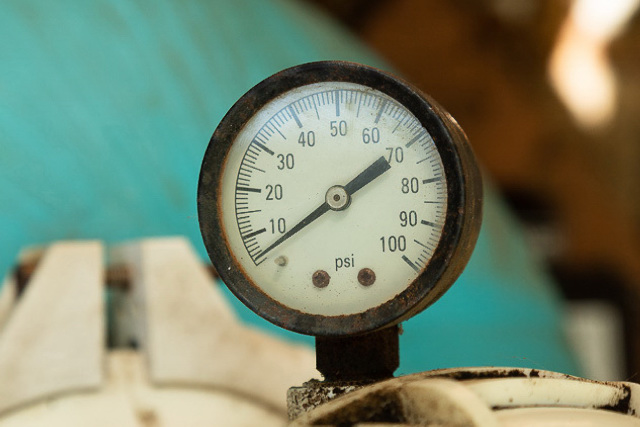
Low pressure is generally caused by a clogged pump basket or because the filter gasket needs to be replaced. Both issues are easy to fix. If the pump basket is clogged, clean it following the instructions below. For the filter canister gasket, buy a new gasket, lube it with PTFE silicone lube, and replace it.
When to Call a Professional
For more serious issues than those listed above, I recommend calling a professional for a couple of reasons. First, what seems like a difficult problem to a pool owner may be an everyday issue for the pool technician, one which he can fix in minimal time with no further damage to the system. The other reason is that if any part of your system is under warranty, home repairs usually will void the warranty.
Pool Maintenance Frequently Asked Questions
Is Pool Maintenance Hard?
Routine pool maintenance isn’t hard, so long as it’s done on a regular basis. If pools are ignored for any length, problems will arise, usually in the form of chemical imbalances or clogged pumps or filters.
Can you do pool maintenance yourself?
You can do most pool maintenance yourself. Serious issues like faulty machinery or heavy algae are best treated by a professional.
How much is DIY pool maintenance?
DIY pool maintenance is relatively inexpensive as long as there are no serious issues. The clients I know who test have me test their chemicals weekly, and usually only need a quart or two of muriatic acid to lower the pH (high pH is a common issue in my area due to fertilizers on the golf course). Additionally, chlorine usually needs adding.
A gallon of muriatic acid is around $11.00, so it is safe to say that they spend less than $30.00 per month on chemicals.
How much is professional pool maintenance per month?
There is no straight answer to this question because it depends on the area you live in. In my area, an average pool maintenance service costs around $180.00 per month for a screened-in pool and around $195.00 for an open pool (no screen). This includes weekly cleaning and water testing, any chemicals that need to be added, and a monthly filter cleaning.
Is the maintenance different for saltwater pools?
Saltwater pool maintenance is slightly different, but the same maintenance routine should be followed. The main difference is that you would test the salt level in the pool instead of the chlorine and clean the salt cell every three months.

